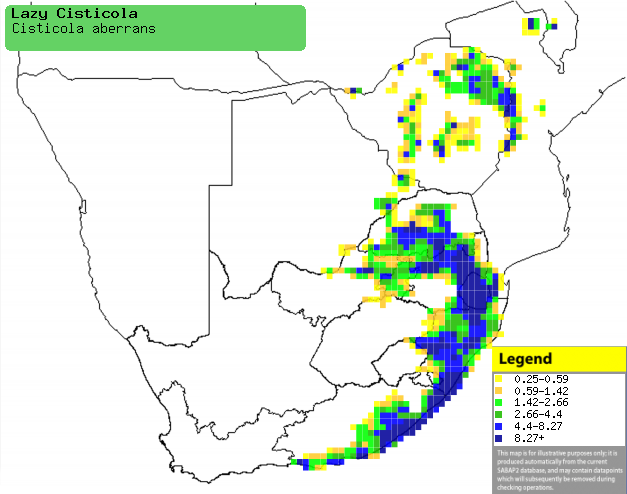|
Cisticola aberrans (Lazy
cisticola)
Luitinktinkie [Afrikaans]; Ungxengezi, Uqume [Xhosa];
uNgcede [Zulu]; Timba (generic name for cisticolas and warblers) [Shona];
Matinti (generic term for cisticola) [Tsonga]; Langstaart-graszanger [Dutch];
Cisticole paresseuse [French]; Smiths zistensänger [German]; Fuinha-preguiçosa
[Portuguese]
Life
> Eukaryotes >
Opisthokonta
> Metazoa (animals) >
Bilateria >
Deuterostomia > Chordata >
Craniata > Vertebrata (vertebrates) > Gnathostomata (jawed
vertebrates) > Teleostomi (teleost fish) > Osteichthyes (bony fish) > Class:
Sarcopterygii (lobe-finned
fish) > Stegocephalia (terrestrial
vertebrates) > Tetrapoda
(four-legged vertebrates) > Reptiliomorpha > Amniota >
Reptilia (reptiles) >
Romeriida > Diapsida > Archosauromorpha > Archosauria >
Dinosauria
(dinosaurs) > Saurischia > Theropoda (bipedal predatory dinosaurs) >
Coelurosauria > Maniraptora > Aves
(birds) >
Order: Passeriformes > Family: Cisticolidae
> Genus: Cisticola
Distribution and habitat
It occurs from Malawi and Zambia through Mozambique to
southern Africa. Here it is locally common in Zimbabwe and eastern South Africa,
preferring rocky outcrops in woodland, open boulder-strewn hillsides with
scattered bushes and trees, forest edges and occasionally gardens.
|
 |
|
Distribution of Lazy cisticola in southern Africa,
based on statistical smoothing of the records from first SA Bird Atlas
Project (©
Animal Demography unit, University of
Cape Town; smoothing by Birgit Erni and Francesca Little). Colours range
from dark blue (most common) through to yellow (least common).
See here for the latest distribution
from the SABAP2. |
Brood parasites
It has been recorded as host of the
Brown-backed honeyguide.
Food
It mainly eats insects, doing most of its foraging near
caves or rock crevices with surrounding vegetation. The following food items have been recorded
in its diet:
Breeding
- The nest is ball-shaped with a side-top entrance, typically built of dry
grass and lined with soft plant down. It is typically placed in a tuft of
grass in thorny scrub, or in a tangle of grass and herbs.
- Egg-laying season is from September-April, peaking from Octover-November.
- It lays 2-4 eggs, which are incubated for about 13-15 days.
- The chicks are mainly cared for by the female, leaving the nest after
about 13-14 days, becoming fully independent about 21-30 days later.
Threats
Not threatened.
References
-
Hockey PAR, Dean WRJ and Ryan PG 2005. Roberts
- Birds of southern Africa, VIIth ed. The Trustees of the John Voelcker
Bird Book Fund, Cape Town.
|
